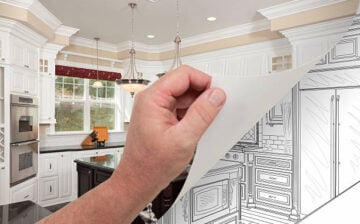
Buying a run-down or neglected property can often seem like an affordable option, especially for first-time buyers. However, buying a fixer-upper home is a big commitment and will take a lot of time, money, and effort. But if you’re up to the challenge, renovating a property can help you get a good return on your investment when it comes to selling and moving again.
Read our beginners guide to finding the right fixer-upper and what to do when you’ve chosen one.
What to Consider When Looking For A Fixer-Upper
There are lots of fixer-upper properties out there that have potential, but it’s essential to choose the right one so that you don’t waste your money and time.
The easiest way to find fixer-upper properties is through a realtor. A qualified realtor has experience and connections to help you find suitable properties, even ones that aren’t on the public market yet.
You can also attend auctions and look at foreclosed homes. But remember that buying a home at an auction usually means you’re buying it as-is.
Condition
While there’s only so much you can tell from a property viewing, it’s important to keep an eye out for any potentially expensive problems. You need to distinguish cosmetic issues and dated décor from substantive things that are going to cost thousands to fix. These are a few of the bigger fixes and renovations older properties might need:
- Replacing old pipes and plumbing
- Updating the electrical systems (especially if they don’t meet today’s standards)
- Replacing windows and doors
- Structural problems, issues with the foundations or the roof
- Damp-proofing and mold removal
- Pest control and damage from pests
Layout
It can be costly to make significant changes to a property, like adding and removing walls. So look for a fixer-upper with a good layout that will make it easy for you to update it.
An open-plan living-dining room layout is trendy and can make a place feel more spacious. But think about how you want the space to work for you, as you’ll have to coordinate the interior throughout, and that might mean that you can’t use the living room or dining room while it’s being renovated.
Location
You should consider the location that you want to buy a fixer-upper. You can make all the improvements to a property, but if it’s not in the right area, its value will not increase as much as you want it to.
Look for up-and-coming neighborhoods that people are starting to move to because they’re more affordable. Take a look at the surrounding homes in the area to see how well they’re maintained and whether they’re owned or rented.
What to Do When You’ve Found a Fixer-Upper
Once you’ve found the perfect fixer-upper for your needs, there are still a few things you should be aware of.
Get the Property Fully Inspected
It’s important to get the property thoroughly inspected. It’s worth spending more on your inspections to find out if there are more serious issues than you thought. Make sure you’re looking at everything from the roof and pests to sewerage. An inspector is trained and equipped to identify issues you might miss, such as a crooked or sinking foundation, drainage problems, or a roof that will soon be in need of replacement. The inspection report will give you a clear idea of the issues the home has, so you’ll have an idea of the effort and cost to repair it and can plan and budget for repair projects.
Get an Idea of Costs
Doing repairs and renovations yourself or with the help of friends or relatives can save you a lot over the cost of contractors. You’ll want to decide which projects you can carry out yourself. You may not be able to build a new garage or rewire the house, but you may be able to paint a wall and replace a toilet.
For some of the more extensive renovations that you won’t be able to do yourself, get quotes. You need to have an idea of how much things are likely to cost and always overestimate. Often, things will take longer or cost more than anticipated.
You’ll also need to determine if a city permit and city inspection are needed for any repairs or renovations. Each locality has different regulations, but permits are often needed for:
- Structural changes like adding or resizing rooms
- Adding new windows
- Adding a garage or storage unit
- Plumbing and electrical work
If a permit and inspection are needed, you’ll have to budget and allow time for these. You may have to provide detailed plans in order to receive a permit.
Find Out What It’ll Be Worth
You need to make sure that you don’t end up spending too much on a fixer-upper, otherwise, you’ll end up losing money when you come to sell. Get an idea of how much other properties in the area are worth, work out the difference from what you’ll be paying for your property, and aim to get it up to a similar standard for less.
Negotiate the House Price
If you’ve found some major issues with the property that are going to cost you thousands, try to negotiate some money off the price. They’re going to have the same problems with any buyers, so it’s worth saving yourself some money to cover some of the essential costs.
The whole point of buying a fixer-upper, after all, is to get the home at a discount. Make sure you account for the cost of needed repairs when making an offer on the home.
You should also include contingencies which allow you to back out of the deal if some negative information surfaces. Two common contingencies are inspection and appraisal contingencies. These allow you to cancel the purchase if the inspection identifies major problems with the home or the home is appraised for significantly less than you offered.
Many lenders have programs for buyers of fixer-uppers, homes in need of major repairs or renovations. Two of these are the Federal Housing Administration 203(k) rehabilitation loan and the Fannie Mae Home Style Renovation Mortgage. With these programs, you can borrow both the purchase price of the home and the cost of renovations in a single loan package.
Know Your Priorities and Limits
Renovating a house can quickly drain all your money and resources if you don’t plan it carefully and stick to a budget. Make a list of all the priorities, updates, and improvements — the things you need to do to make it livable. Outline the costs and how long you expect these things to take so that you know what’s involved.
Then make another list of all the things you’d like to do eventually. Work your way through the first list before starting any cosmetic or less important changes.
Consider Your Living Arrangements
A lot of renovations are noisy, messy, and disruptive. It might be difficult to live there while they’re happening, especially if you’re doing something significant like replacing the roof or the plumbing. So you need to consider whether you can live somewhere else while you get some of the bigger projects completed.
If you can’t stay with friends and family then you may need to pay for a rental property on top of your mortgage payments. You’ll also have to think about moving into the property and whether your possessions will get damaged or if you should put them into storage.
Buying a fixer-upper can be a great project, but it will take time, money, and a lot of effort. So you need to make sure you carefully consider all aspects and be clear on your limits financially and logistically.
We hope you found this blog post A Beginner’s Guide To Buying A Fixer-Upper Home, useful. After reading this essay, you should have picked up a new skill. On this page, you’ll find more recommendations: How to do Home Renovations after Moving to Another House
Have Experience in the Moving Industry? Want an Additional Income Stream? Work With All Around Moving!
Adding a new revenue source to your business can help you increase your profits. Every step of the journey, we’ll be there for you. Click here to learn more.





